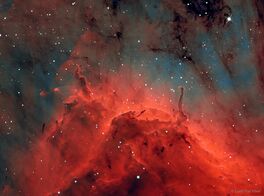Pelikan Nebel: Unterschied zwischen den Versionen
Gerard (Diskussion | Beiträge) KKeine Bearbeitungszusammenfassung |
Gerard (Diskussion | Beiträge) KKeine Bearbeitungszusammenfassung |
||
| Zeile 6: | Zeile 6: | ||
Millions of years from now this nebula might no longer be known as the Pelican, as the balance and placement of stars and gas will leave something that appears completely different. | Millions of years from now this nebula might no longer be known as the Pelican, as the balance and placement of stars and gas will leave something that appears completely different. | ||
{{ClearLine}} | |||
==External links== | ==External links== | ||
Version vom 12. August 2023, 13:21 Uhr
Der Pelikan Nebel (bekannt auch als IC 5070 and IC 5067 is an H II region associated with the North America Nebula in the constellation Cygnus. The gaseous contortions of this emission nebula bear a resemblance to a pelican, giving rise to its name.
The Pelican is much studied because it has a particularly active mix of star formation and evolving gas clouds. The light from young energetic stars is slowly transforming cold gas to hot and causing an ionization front gradually to advance outward. Particularly dense filaments of cold gas are seen to still remain, and among these are found two jets emitted from the Herbig–Haro object 555.
Millions of years from now this nebula might no longer be known as the Pelican, as the balance and placement of stars and gas will leave something that appears completely different.

